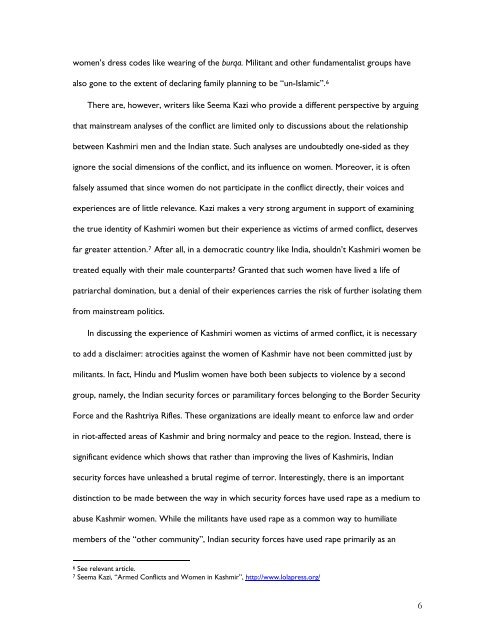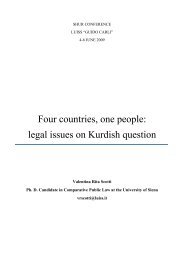The Kashmiri Woman: Identity and Politics - SHUR - Luiss
The Kashmiri Woman: Identity and Politics - SHUR - Luiss
The Kashmiri Woman: Identity and Politics - SHUR - Luiss
You also want an ePaper? Increase the reach of your titles
YUMPU automatically turns print PDFs into web optimized ePapers that Google loves.
women’s dress codes like wearing of the burqa. Militant <strong>and</strong> other fundamentalist groups have<br />
also gone to the extent of declaring family planning to be “un-Islamic”. 6<br />
<strong>The</strong>re are, however, writers like Seema Kazi who provide a different perspective by arguing<br />
that mainstream analyses of the conflict are limited only to discussions about the relationship<br />
between <strong>Kashmiri</strong> men <strong>and</strong> the Indian state. Such analyses are undoubtedly one-sided as they<br />
ignore the social dimensions of the conflict, <strong>and</strong> its influence on women. Moreover, it is often<br />
falsely assumed that since women do not participate in the conflict directly, their voices <strong>and</strong><br />
experiences are of little relevance. Kazi makes a very strong argument in support of examining<br />
the true identity of <strong>Kashmiri</strong> women but their experience as victims of armed conflict, deserves<br />
far greater attention. 7 After all, in a democratic country like India, shouldn’t <strong>Kashmiri</strong> women be<br />
treated equally with their male counterparts? Granted that such women have lived a life of<br />
patriarchal domination, but a denial of their experiences carries the risk of further isolating them<br />
from mainstream politics.<br />
In discussing the experience of <strong>Kashmiri</strong> women as victims of armed conflict, it is necessary<br />
to add a disclaimer: atrocities against the women of Kashmir have not been committed just by<br />
militants. In fact, Hindu <strong>and</strong> Muslim women have both been subjects to violence by a second<br />
group, namely, the Indian security forces or paramilitary forces belonging to the Border Security<br />
Force <strong>and</strong> the Rashtriya Rifles. <strong>The</strong>se organizations are ideally meant to enforce law <strong>and</strong> order<br />
in riot-affected areas of Kashmir <strong>and</strong> bring normalcy <strong>and</strong> peace to the region. Instead, there is<br />
significant evidence which shows that rather than improving the lives of <strong>Kashmiri</strong>s, Indian<br />
security forces have unleashed a brutal regime of terror. Interestingly, there is an important<br />
distinction to be made between the way in which security forces have used rape as a medium to<br />
abuse Kashmir women. While the militants have used rape as a common way to humiliate<br />
members of the “other community”, Indian security forces have used rape primarily as an<br />
6 See relevant article.<br />
7 Seema Kazi, “Armed Conflicts <strong>and</strong> Women in Kashmir”, http://www.lolapress.org/<br />
6



